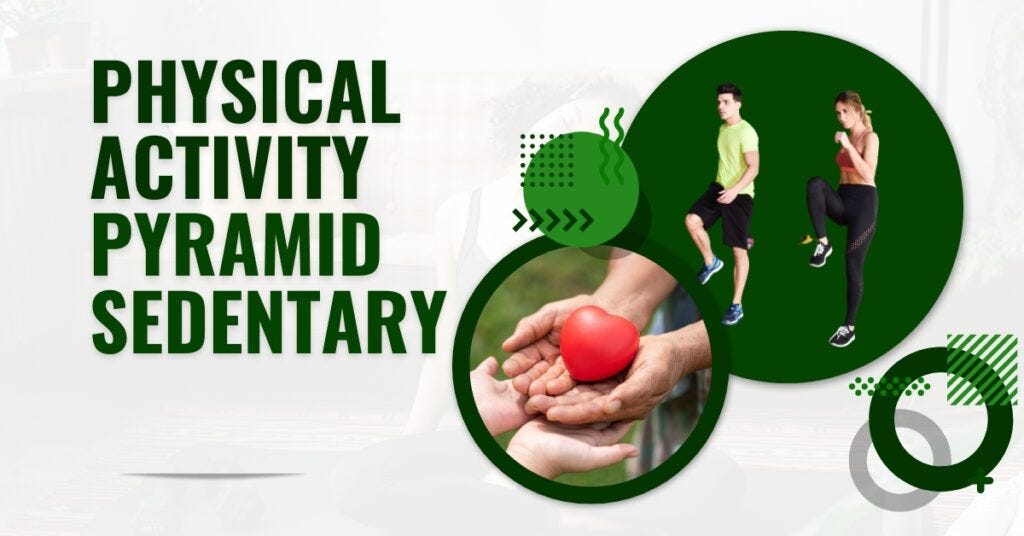Conquering the Pyramid: Where Sedentary Activities Reside
The physical activity pyramid, a cornerstone of fitness guidelines, visually depicts the recommended types and amounts of exercise for overall health and well-being. It serves as a roadmap to an active lifestyle, but where do activities we spend most of our days doing – sitting, watching TV, browsing the web – fit into this pyramid? The answer: they don’t truly belong on any of the active levels. Sedentary activities reside at the very top of the pyramid, representing the behaviors we should aim to limit.
Understanding the Pyramid’s Levels
The physical activity pyramid is typically divided into four tiers, each representing different categories of physical activity and their recommended daily or weekly durations. Here’s a breakdown of the pyramid’s levels, moving from the base to the summit:
- Level 4: Sedentary Activities (The Summit)
- This level encompasses activities with minimal energy expenditure, often characterized by prolonged sitting or lying down. Examples include watching television, using computers, reading, or commuting by car.
- Level 3: Light-Intensity Aerobic Activities
- These activities elevate your heart rate and breathing slightly but don’t leave you breathless. Examples include leisurely walking, light housework, or gentle yoga.
- Level 2: Moderate-Intensity Aerobic Activities
- Moderate-intensity activities require a noticeable increase in heart rate and breathing, making it difficult to hold a conversation while exercising. Examples include brisk walking, cycling, swimming, or dancing.
- Level 1: Vigorous-Intensity Aerobic Activities
- These activities significantly elevate your heart rate and breathing, making conversation very difficult. Examples include running, jumping rope, intense sports like squash or basketball.
Why Sedentary Activities Deserve the Top Spot (and How to Move Down)
Sedentary behaviors are a growing concern in today’s world. Spending excessive time sitting has been linked to numerous health risks, including obesity, type 2 diabetes, heart disease, and even some cancers. The physical activity pyramid positions sedentary activities at the top to emphasize the importance of minimizing them and prioritizing activities from the lower levels.
Here’s how to swap sedentary habits for those that reside on lower levels of the pyramid:
- Become a Movement Enthusiast: Look for opportunities to incorporate movement into your daily routine. Take the stairs instead of the elevator, walk or cycle for short errands, do some stretches or light exercises during commercial breaks while watching TV.
- Embrace Active Work Breaks: If your job involves prolonged sitting, take short activity breaks every 30 minutes. Walk around the office, do some desk stretches, or climb a few flights of stairs.
- Befriend Light Activities: Choose light-intensity activities you enjoy. Take a leisurely walk in nature, do some light gardening, or dust off your dancing shoes.
- Gradually Intensify: As your fitness level improves, gradually incorporate moderate-intensity activities like brisk walking or cycling into your routine.
The Benefits of Moving More
The rewards of replacing sedentary time with activities from lower levels of the pyramid are numerous:
- Improved Physical Health: Regular physical activity strengthens your heart, improves blood sugar control, reduces the risk of chronic diseases, and helps maintain a healthy weight.
- Enhanced Mental Well-being: Exercise is a powerful mood booster, reducing stress, anxiety, and symptoms of depression. It can also improve sleep quality and cognitive function.
- Increased Energy Levels: Regular physical activity combats fatigue and increases energy levels throughout the day.
- Stronger Bones and Muscles: Exercise strengthens bones and muscles, improving balance, coordination, and reducing the risk of falls.
Beyond the Pyramid: Additional Tips for Success
While the physical activity pyramid is a valuable tool, here are some additional tips to set yourself up for success:
- Set Realistic Goals: Start with small, achievable goals and gradually increase the intensity and duration of your activities as you get fitter.
- Find an Exercise Buddy: Enlist a friend or family member to join you for walks, bike rides, or group fitness classes. The social aspect can boost motivation and enjoyment.
- Make it Fun: Choose activities you enjoy. Explore different exercise options until you find something you look forward to doing.
- Track Your Progress: Monitor your progress using a fitness tracker or app. Seeing improvement can be a great motivator.
- Listen to Your Body: Don’t push yourself too hard, especially when starting. Take rest days when needed and pay attention to any pain signals.
Frequently Asked Questions (FAQ)
-
How much sedentary time is too much?
- While there’s no one-size-fits-all answer, experts generally recommend aiming to limit sitting time to less than 8 hours per day.






More Stories
Where to Watch USMNT vs Jamaica National Football Team
How I Met My Monster
How Should a Ring Fit